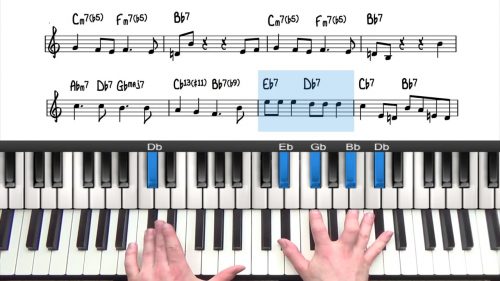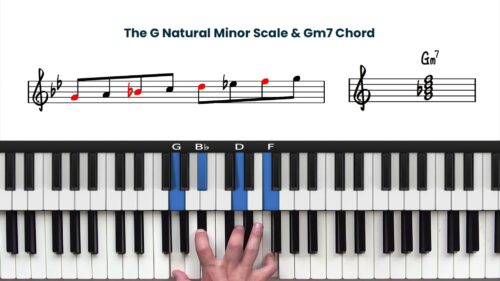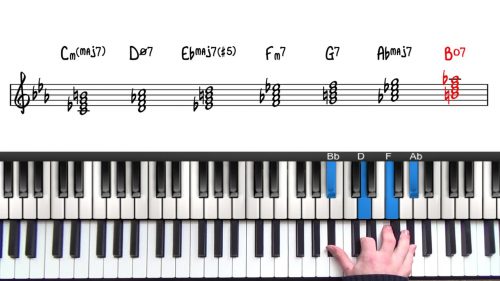“When Sunny Get’s Blue” For Beginners
Welcome to this beginner focused lesson on the tune “When Sunny Gets Blue”. We will be sticking to simple voicings containing the root, 3rd, and 7th of each chord and then the melody on top.
The Form & Chord Changes
“When Sunny Get’s Blue” follows a 32 bar AABA form and is commonly played in the key of F Major. The form is mostly comprised of 25s and 251s which makes it a great tune for beginners so that we can isolate the voice leading in these common progressions.
We start this tutorial by discussing the form of the tune and how recognising the AABA form can help to speed up the memorisation process of the chords and melody. We then analyse the chord changes and identify any common progressions such as 25s and 251s.
Rephrasing The Melody
The A section of the tune repeats 3 times which means that we have a repetitive melody for much of the form. We will discuss some simple ways to rephrase the melody to add interest and variety to the otherwise repetitive melody line.
As jazz musicians we have the creative freedom to rephrase the melody in many different ways. We can add notes in, take notes out, change the rhythm of the melody, change the placement of the melody, and add ornamentation such as trills, turns, and grace notes. We will explore these different options and apply them throughout the lesson.
Practice Tips
-
Search for notable vocal recordings of the song to familiarise yourself with the lyrics and the meaning behind them.
-
Knowing the lyrics helps to phrase the melody and express the meaning behind the song.
-
Pay attention to the voice leading in the 25s and 251s. The b7th always drops by a half step to become the 3rd of the next chord.
-
Experiment with voicings in different registers of the piano. The A section repeats 3 times and utilise the different registers of the piano to add interest and variety to your arrangement.
-
Compile a list of your favourite recordings and listen and transcribe the parts you like. This is how we develop our own sound or 'voice' when playing jazz piano.
-
If you're new to transcription, check out the transcription exercises in the PianoGroove community area: https://www.pianogroove.com/community/c/improvisation-exercises







Hi Hayden. Do you have the full trancripsion arrangement of this nice tune. Please i would love to have it to study.
Hi Jimmy 👋
Yes I will get the transcription completed asap.
Apologies for the delay!
Cheers,
Hayden
When will you be posting the transcription for this tune?
Hi Gary,
I will transcribe it this week, apologies for the delay.
Cheers,
Hayden
Hi Gary,
The transcription is now available in the downloads section.
Enjoy the lessons.
Cheers,
Hayden
I wasn’t familiar with this tune so I went searching for it on YouTube. First one was Norah Jones, with solo piano. Really sweet.
HI Hayden,
Where can I find the advanced version of “When sunny gets blues, please?
Regards,
Brian
I apologise Hayden, I found your transcription for my question.
Many thanks,
Regards,
Brian
Normally, the second F in measure 19 would be played as F# just as the first one is.
Hi Lee 👋🏻
Yes that’s correct, that note could be played as the F#.
When playing jazz standards, we have the creative freedom to change the melody, rephrase it, add notes in, take notes away etc…
In this case, I like the sound of the F natural over the A7 as F is the #5 of A7 which works well with the b9 in the chord and creates a very nice chord flavour.
If chord alterations are new to you, check out the following lesson for a quick introduction:
pianogroove.com/jazz-piano-lessons/hearing-resolving-altered-tensions/
and we have a full course on the subject here: pianogroove.com/jazz-piano-lessons/altered-harmony-upper-structure-triads/
I hope that helps Lee, and let me know if I can be of further assistance.
Cheers,
Hayden
Hi Hayden,
I’ve been around altered harmony for many years and I’m aware that you mention (in several lessons) how jazz “allows” the freedom to change the melody, etc. The motivation behind my comment was that other members might not be aware that F# is actually the “correct” note in this case due to the sharp sign that appears previously in the measure. You make no mention of that as you describe how the F natural functions.
Lee
Hi Lee,
Yes I agree that could be more clear and apologies for missing that detail.
Interestingly some recordings play the #5 whilst others play the 13. Both options sound great so I always encourage students to follow their ears.
Cheers and stay safe!
Hayden
Another lovely song. Keep up the good work Hayden!
Thanks Adam – glad you enjoyed the tutorial and hope you are keeping well.
Cheers,
Hayden
Hi Hayden,
Thanks for the wonderful lesson. I have a general question about the pedaling technique. I notice when I sustain the grace notes in the A section, everything sounds a bit blurry. Can you kindly elaborate on the pedalling technique?
Thanks a lot :)
Hi Hayden,
Thanks for this wonderful arrangement. I was wondering if I could use irealpro to practice along? I am pretty new at it so your advice would be very helpful.
Many Thanks,
Rishi
Hi Rishi,
Yes playing along with iRealPro can be useful, but it is more used when we are playing with rootless voicings and often with faster tunes where we are trying to replicate a jazz band with bass player and drummer.
In this lesson we are playing the bass notes in our voicings and so we would not need the bass in the backing track.
Using a simple metronome beat can be useful to work on your sense of time, however, when I play ballads I do pull and push on the time a little which I like to do to add more feeling and emotion. I would say a metronome would be more suitable for you here than iRealPro.
My main recommendation Rishi is to aim to build a repertoire of 20 or so jazz standards, and at that point I guarantee that you will be much more comfortable reading an interpreting lead sheets. Ultimately, it’s a numbers game, the more jazz standards we learn, the easier it becomes to learn new ones as they are very similar in their structure and harmonies.
Firstly, I’d recommend that you learn the jazz standard arrangements in this course.
And then watch the following 2 lessons in the Extended Harmony Course. We start with the most basic chord voicings possible, and then gradually layer in some interesting chord extensions.
Misty: pianogroove.com/jazz-piano-lessons/misty-tutorial-lesson/
Tenderly: pianogroove.com/jazz-piano-lessons/tenderly-jazz-standard/
You will forget some songs as you learn new ones, but we are learning these tunes for all of our lives and so it is a gradual process to learn them by memory.
You will also prefer some songs over others, which is very natural, the best thing to do is to play as many as possible and then pick your favourites for deeper study.
Here to help if you have any other questions.
Cheers,
Hayden
Dear Hayden,
Thanks a lot for your advice :)
I will keep working on jazz standards and foundation drills.
The next one I would like to learn is The Nearness of You.
Thanks again and Kind Regards,
Rishi
My pleasure Rishi.
For the nearness of you, I would first recommend checking out the beginner lesson here: pianogroove.com/jazz-piano-lessons/nearness-of-you-for-beginners/
Next, I hosted a live seminar where we explore the tune in much more detail: pianogroove.com/live-seminars/nearness-of-you-solo/
The second link is more advanced but it will show you what we will be learning in the upcoming courses and also includes some important information on how to learn and memorise the form and chord changes of jazz standards.
Cheers,
Hayden
Just beautiful!